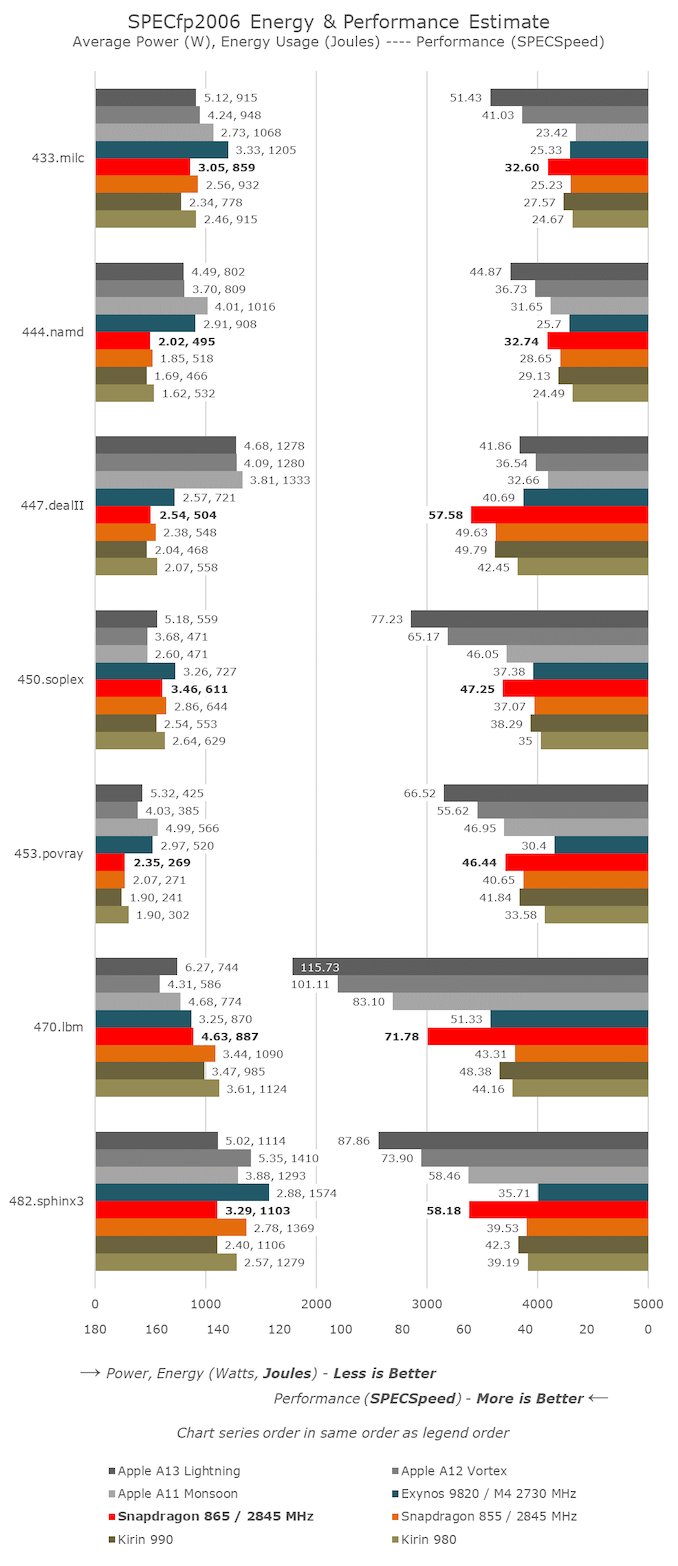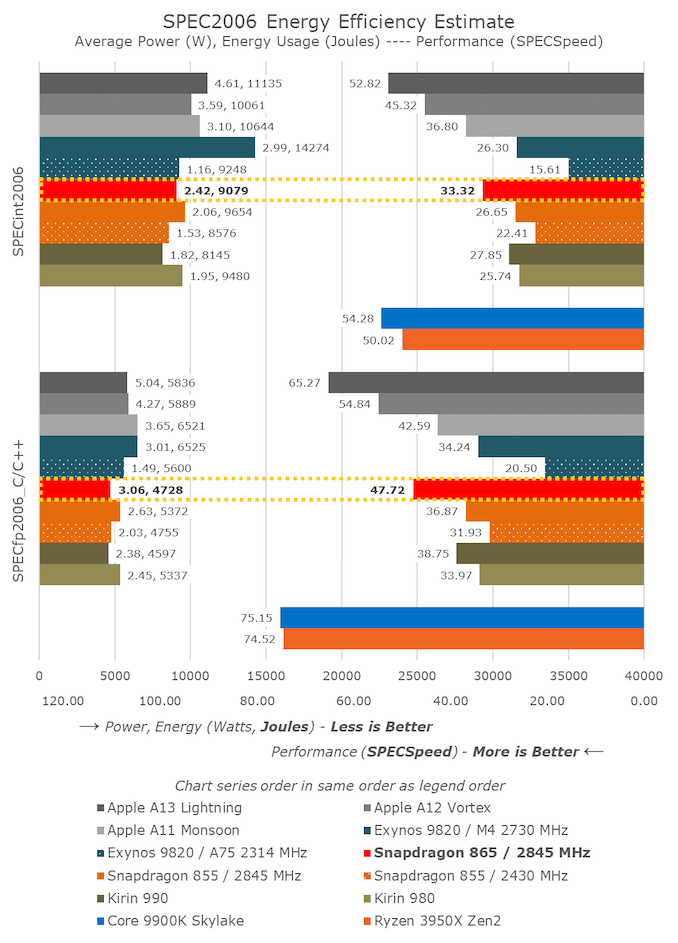The Snapdragon 865 Performance Preview: Setting the Stage for Flagship Android 2020
by Andrei Frumusanu on December 16, 2019 7:30 AM EST- Posted in
- Mobile
- Qualcomm
- Smartphones
- 5G
- Cortex A77
- Snapdragon 865
CPU Performance & Efficiency: SPEC2006
We’re moving on to SPEC2006, analysing the new single-threaded performance of the new Cortex-A77 cores. As the new CPU is running at the same clock as the A76-derived design of the Snapdragon 855, any improvements we’ll be seeing today are likely due to the IPC improvements of the core, the doubled L3 cache, as well as the enhancements to the memory controllers and memory subsystem of the chip.
Disclaimer About Power Figures Today:
The power figures presented today were captured using the same methodology we generally use on commercial devices, however this year we’ve noted a large discrepancy between figures reported by the QRD865’s fuel-gauge and the actual power consumption of the device. Generally, we’ve noted that there’s a discrepancy factor of roughly 3x. We’ve reached out to Qualcomm and they confirmed in a very quick testing that there’s a discrepancy of >2.5x. Furthermore, the QRD865 phones this year again suffered from excessive idle power figures of >1.3W.
I’ve attempted to compensate the data as best I could, however the figures published today are merely preliminary and of lower confidence than usual. For what it’s worth, last year, the QRD855 data was within 5% of the commercial phones’ measurements. We’ll be naturally re-testing everything once we get our hands on final commercial devices.
In the SPECint2006 suite, we’re seeing some noticeable performance improvements across the board, with some benchmarks posting some larger than expected increases. The biggest improvements are seen in the memory intensive workloads. 429.mcf is DRAM latency bound and sees a massive improvement of up to 46% compared to the Snapdragon 855.
What’s interesting to see is that some execution bound benchmarks such as 456.hmmer seeing a 28% upgrade. The A77 has an added 4th ALU which represents a 33% throughput increase in simple integer operations, which I don’t doubt is a major reason for the improvements seen here.
The improvements aren’t across the board, with 400.perlbench in particular seeing even a slight degradation for some reason. 403.gcc also saw a smaller 12% increase – it’s likely these benchmarks are bound by other aspects of the microarchitecture.
The power consumption and energy efficiency, if the numbers are correct, roughly match our expectations of the microarchitecture. Power has gone up with performance, but because of the higher performance and smaller runtime of the workloads, energy usage has remained roughly flat. Actually in several tests it’s actually improved in terms of efficiency when compared to the Snapdragon 855, but we’ll have to wait on commercial devices in order to make some definitive conclusions here.
In the SPECfp2006 suite, we’re seeing also seeing some very varied improvements. The biggest change happened to 470.lbm which has a very big hot loop and is memory bandwidth hungry. I think the A77’s new MOP-cache here would help a lot in regards to the instruction throughput, and the improved memory subsystem makes the massive 65% performance jump possible.
Arm actually had advertised IPC improvements of ~25% and ~35% for the int and FP suite of SPEC2006. On the int side, we’re indeed hitting 25% on the Snapdragon 865, compared to the S855, however on the FP side we’re a bit short as the increase falls in at around 29%. The performance increases here strongly depend on the SoC and particular on the memory subsystem, compared to the Kirin 990’s A76 implementation the increases here are only 20% and 24%, but HiSilicon’s chip also has a stronger memory subsystem which allows it to gain quite more performance over the A76’s in the S855.
The overall results for SPEC2006 are very good for the Snapdragon 865. Performance is exactly where Qualcomm advertised it would land at, and we’re seeing a 25% increase in SPECint2006 and a 29% in SPECfp2006. On the integer side, the A77 still trails Apple’s Monsoon cores in the A11, but the new Arm design now has been able to trounce it in the FP suite. We’re still a bit far away from the microarchitectures catching up to Apple’s latest designs, but if Arm keeps up this 25-30% yearly improvement rate, we should be getting there in a few more iterations.
The power and energy efficiency figures, again, taken with a grain of salt, are also very much in line with expectations. Power has slightly increased with performance this generation, however due to the performance increase, energy efficiency has remained relatively flat, or has even seen a slight improvement.














178 Comments
View All Comments
jospoortvliet - Monday, December 16, 2019 - link
The best snapdragon can barely keep up with the a11, as Andrei points out in his analysis. YouTube speed tests are by far the most useless and pointless benchmarks ever devised, which is why not a single reputable source (like anandtech) ever uses them...Sorry, but the only question here is how much faster the a14 will be. 40%, 50% or even more...
Kishoreshack - Monday, December 16, 2019 - link
Why doesn't Qualcomm simply increases their die size & use a larger die properly to at least come closer to applemaybe it is needs more than a larger die size
it needs a better Architecture
Arm or Qualcomm whom to blame?
eastcoast_pete - Monday, December 16, 2019 - link
A key problem for smartphones is power budget. These SoCs are already pushing 5 W/h and up if running at full tilt, so even a nicely sized battery (5000 mAh) can be drained in 3-4 hours top if someone runs them accordingly. Apple has managed to accommodate high peak/burst performance while still getting good overall power usage, and I still find their battery life wanting.Quantumz0d - Monday, December 16, 2019 - link
Why do they need to ? Apple is only Apple and it only works for them.If you see realworld speedtests on YouTube see how OP7 Pro flies through the tasks giving the user a faster and smoother experience.
And go to ScyllaDB website and see how AWS Graviton 2 stacks with Intel in Benches and how they mention benches only should not be taken as a measure.
Apple OS lacks Filesystem. It cannot be a computer ever. iOS is a kid friendly OS. You can't even fucking change launcher / icons forget other system level changes.
Qcomm needs competition from MediaTek, Exynos. Huawei HiSilicon but except Exynos all are garbage because they do not let us unlock Bootloaders. And Android phones see community driven ROMs there is so much or choice to add even the DAPs from 200USD to 3000USD have Qcomm technology.
Repairing is also easier due to the HW Boxes which can bring a QComm9008 Brick to life. Whereas with Apple its Ball and Chain ecosystem.
I see my SD835 run like butter through everything I throw at it and has an SD slot too.
This stupid Whiteknighting of Apple processors beating x86 and their use case / Android Phones is a big sham. People need to realize benches are not the only case when you compare Processors accross OSes.
jospoortvliet - Monday, December 16, 2019 - link
A 1995 computer running MS DOS 6.0 is also butter smooth, I hope you dont think that means an intel 486 DX4 is faster than an apple chip.Please stop with your nonsense about "real world tests". Real world your 835 has a slower cpu, GPU, and storage. Doesn't mean it is garbage - it is fine you are happy with it but it is not your duty to defend the honor of Oppo against facts. I dont want an iphone either die to their walked garden but that doesn't mean I live under the delusion that my brand new galaxy s10e is anything other than at least 40% slower and twice as inefficient as an iPhone 11...
cha0z_ - Friday, December 27, 2019 - link
Coming from exynos 9810 note 9 to iphone 11 pro max... the SOC on the iphone is literally times faster and more efficient than the exynos. The difference is absurdly big and people still calls apple slower because of design choices (like the slow animations, etc). It's super smooth in all conditions/times + it's rofl fast in any app/game (not to mention apps got functions not available on android). GL running full PC civilization 6 on android with decent performance later in the game on bigger map and decent battery life. There is a reason why the game was not ported on android too (and not only piracy) - it will run poor even on most high end current gen android phones.ksec - Monday, December 16, 2019 - link
They could, but are you going to pay for it? Let say Qualcomm has to bump up $50 ( inclusive of their profits ) to reach the same level of performance, as you consumer you will have to pay roughly $100 more.In a cut throat Android market, who is going to risk putting up their Smartphone price by $100?
There is a reason why Samsung and Huawei are trying to make SoC themselves, instead of putting those profits into Qualcomm's hand, they want those cost to go towards more die space to better differentiate their product and compete with Apple.
Now here is another question, how many consumer will notice the different in CPU speed? And how many consumer will notice the Modem quality different?
They are all set of trade offs, not only in engineering, but also in cost, markets, risk... etc...
jospoortvliet - Monday, December 16, 2019 - link
It is a matter of cost. Arm could design a cpu core that is 4 times the size of the a76 and 50% faster, catching up to apple. But that would cost a lot of die size and thus money... for high margin, high cost devices it is ok but not for cheap ones. Ape can afford this...jospoortvliet - Monday, December 16, 2019 - link
Ape - I mean apple of course!cha0z_ - Friday, December 27, 2019 - link
It's not that simple as putting a lot of transistors in it. You can somewhat tackle the problem with that, but by itself it will not lead to the desired end result.I can elaborate, but it will be lengthily and highly technical post.